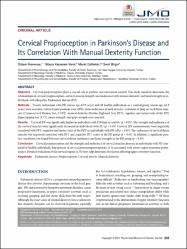| dc.contributor.author | Menevşe, Özlem | |
| dc.contributor.author | Kepenek Varol, Büşra | |
| dc.contributor.author | Gültekin, Murat | |
| dc.contributor.author | Bilgin, Sevil | |
| dc.date.accessioned | 2024-04-16T13:15:10Z | |
| dc.date.available | 2024-04-16T13:15:10Z | |
| dc.date.issued | 2023 | en_US |
| dc.identifier.citation | Menevşe, Ö., Kepenek Varol, B., Gültekin, M., & Bilgin, S. (2023). Significance of Plasma Irisin, Adiponectin, and Retinol Binding Protein-4 Levels as Biomarkers for Obstructive Sleep Apnea Syndrome Severity. Journal Information BIOMOLECULES, 16(3), 295-306. https://doi.org/10.14802/jmd.23039 | en_US |
| dc.identifier.issn | 2093-4939 | |
| dc.identifier.uri | https://hdl.handle.net/20.500.12900/339 | |
| dc.description.abstract | ObjectiveaaCervical proprioception plays a crucial role in posture and movement control. This study aimed to determine the
relationships of cervical proprioception, cervical muscle strength and endurance with manual dexterity and hand strength in individuals with idiopathic Parkinson’s disease (PD).
MethodsaaTwenty individuals with PD (mean age: 63.9 years) and 20 healthy individuals as a control group (mean age: 61.9
years) were recruited. Cervical joint position error (JPE), static endurance of neck muscles, activation of deep cervical flexor muscles (Craniocervical Flexion Test, CCFT), manual dexterity (Purdue Pegboard Test, PPT), cognitive and motor tasks of the PPT,
finger tapping test (FTT), pinch strength, and grip strength were assessed.
ResultsaaCervical JPE was significantly higher in individuals with PD than in controls (p < 0.05). The strength and endurance of
the cervical muscles were significantly decreased in individuals with PD (p < 0.05). Cervical JPE measurements were negatively
correlated with PPT, cognitive and motor tasks of the PPT in individuals with PD (all p < 0.05). The endurance of cervical flexor
muscles was negatively correlated with PPT and cognitive PPT scores in the PD group (p < 0.05). In addition, a significant positive correlation was found between cervical flexor endurance and hand strength in the PD group (p < 0.05).
ConclusionaaCervical proprioception and the strength and endurance of cervical muscles decrease in individuals with PD compared to healthy individuals. Impairment of cervical proprioception appears to be associated with poorer upper extremity performance. Detailed evaluation of the cervical region in PD may help determine the factors affecting upper extremity function. | en_US |
| dc.language.iso | eng | en_US |
| dc.publisher | KOREAN MOVEMENT DISORDERS SOC | en_US |
| dc.relation.isversionof | 10.14802/jmd.23039 | en_US |
| dc.rights | info:eu-repo/semantics/openAccess | en_US |
| dc.subject | Parkinson hastalığı | en_US |
| dc.subject | Parkinson’s disease | en_US |
| dc.subject | Propriyosepsiyon | en_US |
| dc.subject | Proprioception | en_US |
| dc.subject | Servikal kas | en_US |
| dc.subject | Cervical muscle | en_US |
| dc.subject | El becerisi | en_US |
| dc.subject | Manual dexterity | en_US |
| dc.title | Cervical Proprioception in Parkinson's Disease and Its Correlation With Manual Dexterity Function | en_US |
| dc.type | article | en_US |
| dc.department | İstanbul Atlas Üniversitesi, Tıp Fakültesi, Dahili Tıp Bilimleri Bölümü | en_US |
| dc.authorid | https://orcid.org/0000-0002-0609-4269 | en_US |
| dc.contributor.institutionauthor | Gültekin, Murat | |
| dc.identifier.volume | 16 | en_US |
| dc.identifier.issue | 3 | en_US |
| dc.identifier.startpage | 295 | en_US |
| dc.identifier.endpage | 306 | en_US |
| dc.relation.journal | JOURNAL OF MOVEMENT DISORDERS | en_US |
| dc.relation.publicationcategory | Makale - Uluslararası Hakemli Dergi - Kurum Öğretim Elemanı | en_US |

















